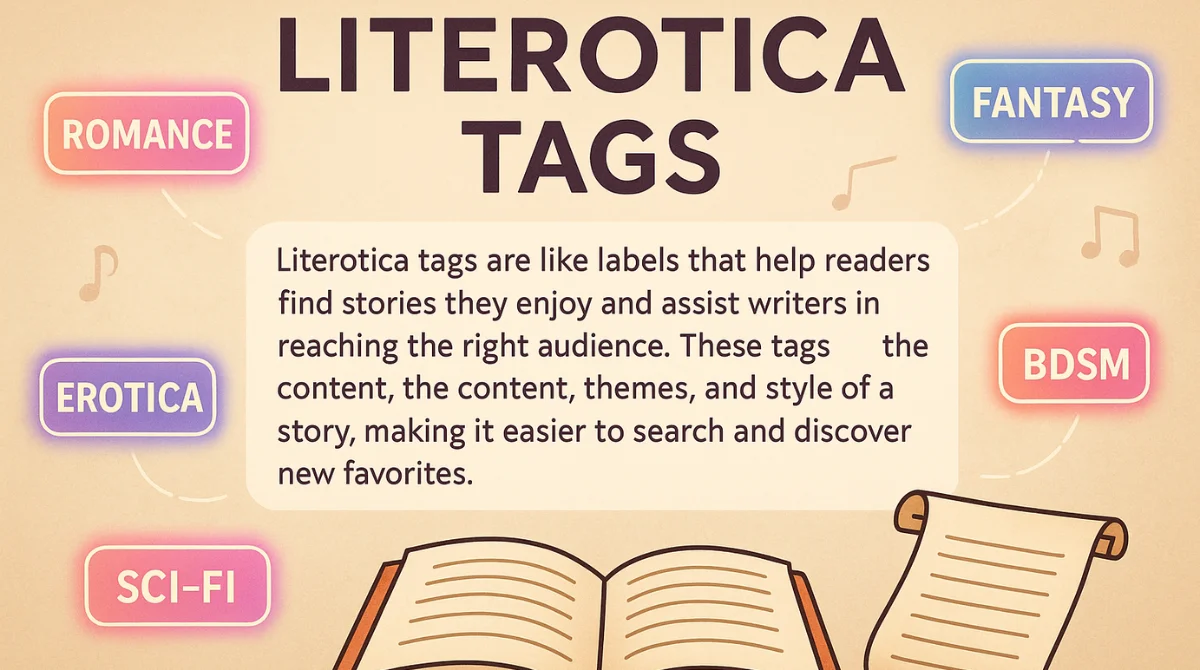Literotica tags are like labels that help readers find stories they enjoy and assist writers in reaching the right audience. These tags describe the content, themes, and style of a story, making it easier to search and discover new favorites.
What Are Literotica Tags?
Literotica tags are words or short phrases that writers add to their stories to tell readers what the story is about. Think of them like labels or signs that give a quick idea of what kind of things you’ll find in the story.
For example:
- If a story has the tag “BDSM”, it means the story will include themes like bondage, control, power play, or other similar activities.
- If it’s tagged “Romance”, the focus is more on love, feelings, and emotional relationships between characters.
These tags help readers find stories they like without wasting time. It’s kind of like how people use hashtags on Instagram or Twitter to group posts by topic. If you search for a certain tag, you’ll see all the stories that have that theme.
So, if someone enjoys reading love stories, they can click on the “Romance” tag and find dozens of romantic stories. If someone is into fantasy or roleplay, they can use those tags too. It’s all about making it easier for everyone—readers and writers—to connect over what they enjoy.
Why Are Tags Important?
Tags play a big role in helping everyone on Literotica—whether you’re reading or writing. Here’s why they matter:
1. For Readers
Imagine you want to read a certain type of story—maybe something romantic, or something with a fantasy twist. Instead of scrolling through thousands of random stories, tags help you find exactly what you’re in the mood for.
For example, if you love reading about “forbidden love” or “office romance”, you can search for those specific tags and instantly find stories that match. This saves a lot of time and makes reading more enjoyable.
2. For Writers
When a writer adds the right tags to their story, it becomes easier for the right readers to find it. If someone is looking for a story with the tag “BDSM” or “Age Gap”, and the writer has used those tags correctly, that story will show up in the search results.
This means more readers will click on the story, read it, and maybe even leave a comment or rating. So, tagging helps writers get more views and better engagement.
3. For the Community
Tags also help create small groups or communities within the larger platform. For example, people who love “sci-fi erotica” or “lesbian romance” often look for stories under those tags. Over time, they might start recognizing writers, styles, or even form conversations based on shared interests.
This makes Literotica feel more welcoming and personal, where people with similar tastes can connect and share what they love.
In Short:
- Tags save time for readers
- They help writers reach the right audience
- They build small fan groups around different genres and themes
So yeah, tags may seem like small details, but they’re actually super important for the whole reading and writing experience!
Common Literotica Tags and Their Meanings
When reading or writing on Literotica, you’ll notice that most stories have tags attached to them. These tags help describe what the story is about. Let’s go through some of the most common ones and what they really mean:
1. BDSM
This tag stands for Bondage, Discipline, Dominance, Submission, Sadism, and Masochism.
Stories with this tag often involve one person taking control and the other willingly giving it up. It might include things like tying someone up, using safe pain, giving commands, or playing power games. It’s always meant to be consensual and based on trust between characters.
2. Romance
These stories focus more on feelings, emotions, love, and relationships.
The physical part is there too, but the main goal is to show how two people connect emotionally. If you’re someone who enjoys reading about falling in love, sweet moments, and happy endings, this is the tag for you.
3. Taboo
This tag covers themes that are forbidden, controversial, or considered off-limits in everyday life.
Examples include step-sibling love, teacher-student relationships, or other situations where society might raise eyebrows. These stories are fictional and often explore “what if” fantasies that break normal boundaries.
4. Exhibitionism
In these stories, the characters enjoy being seen or watched during intimate moments.
The excitement comes from the risk of being caught, or sometimes they want others to see on purpose. It might involve public places or open windows, and it’s all about that thrill of exposure.
5. Ménage
This tag is for stories that include three or more people in one relationship or scene.
It can be a threesome or even more partners involved. The focus is usually on how the group interacts together—sometimes emotionally, sometimes just physically.
6. Roleplay
In roleplay stories, the characters pretend to be someone else or act out a fantasy.
For example, a couple might pretend to be strangers meeting for the first time, or a boss and secretary. It’s about acting out fun, exciting, or even silly situations to spice things up.
7. Incest (Consensual)
These are fictional stories where family members are involved with each other, but the key word is “consensual”—meaning both people agree to it and want it.
Even though it’s a taboo in real life, in fiction some people explore this fantasy. Remember, these are just stories and not meant to be taken as real-life advice or behavior.
8. Fetish
A fetish tag means the story focuses on a very specific thing that turns someone on.
This could be anything from feet, leather, latex clothing, spanking, or even certain types of clothing or objects. Everyone has different preferences, and these stories dive deep into one of those unique interests.
Why Knowing These Tags Helps
When you understand what these tags mean, you can:
- Pick stories you’ll enjoy
- Avoid stories you’re not comfortable with
- Tag your own stories properly if you’re a writer
It also helps build respect in the community, because people can choose what they want to read and feel safe and understood while doing so.
Tips for Using Tags Effectively
Using tags the right way can really improve your experience on Literotica. It helps you find what you’re looking for faster if you’re a reader and makes sure your story reaches the right audience if you’re a writer.
Let’s go through the tips one by one:
1. Be Specific
Don’t just use general tags like “erotic” or “hot”. Instead, try to be clear and detailed about what the story actually includes.
For example:
- Instead of just writing “Erotic”, use “Office Romance” if the story is about coworkers.
- Instead of “Sexy”, try “BDSM Fantasy” if the story involves power play and domination.
This helps readers know exactly what to expect, and they’re more likely to click and enjoy the story because it fits their interest. It also helps your story show up in more accurate searches.
2. Limit the Number of Tags
It might be tempting to add a lot of tags to try and reach more people—but using too many can actually confuse readers.
Think of tags like a menu at a restaurant—too many options can be overwhelming. Instead, choose a few (maybe 5–7 max) that truly match your story’s content.
This keeps the focus clear, and readers will appreciate knowing what the story is really about.
3. Update Tags When Necessary
Sometimes, as a writer, your story might change as you add new chapters or get feedback. Maybe a new theme comes in later that wasn’t there at the start. In that case, it’s a good idea to go back and edit your tags.
Also, if readers leave comments or questions that show confusion about your story’s theme, maybe your tags need to be clearer or more accurate.
Keeping your tags updated means your story stays relevant, and people always know what to expect.
Why This Matters?
- For Readers: You find better stories faster, and avoid ones you’re not into.
- For Writers: You attract the right readers, which means better feedback, more reads, and a loyal audience.
- For Everyone: It keeps the platform more organized, respectful, and enjoyable.
Exploring New Genres Through Tags
Tags on Literotica help readers explore genres they may not have considered before. For example, a reader who loves “Romance” might discover a new interest in “Sci-Fi Erotica” through related tags. This encourages readers to step out of their comfort zones and try stories in different genres, such as “Fantasy Romance” or “Paranormal Erotica.” By exploring these new genres, readers can expand their tastes, find fresh writing styles, and enjoy new types of stories. Tags broaden horizons and make the reading experience more exciting and diverse, offering endless possibilities beyond familiar genres.
Conclusion
Literotica tags play a crucial role in making stories easier to find and ensuring readers discover content that matches their interests. When used correctly, tags help readers quickly locate stories they’ll enjoy based on specific themes, genres, or preferences. For writers, using the right tags ensures their stories are seen by the right audience, helping them gain more readers and feedback.
By understanding how tags work and using them wisely, both readers and writers can have a better experience on the platform. Tags make searching easier, allow for better connections between stories and audiences, and enhance the overall enjoyment of the community.



